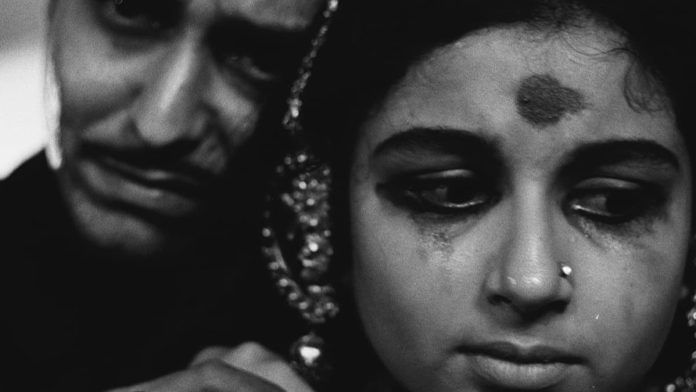More than six decades have passed since Satyajit Ray released Devi in 1960. If it came out today, the film probably wouldn’t last in theatres for more than a few days, triggering the blind faith and superstition that continues to shape the collective conscience. Ray’s message is still as piercing.
Devi is arguably one of the rawest portrayals of how devotion destroys what it seeks to protect. How it can curdle into obsession. How religion, when unchecked, can consume reason.
The film is set up in rural Bengal in a zamindar’s household headed by the deeply religious Kalikinkar Choudhuri (Chhabi Biswas). His devotion to Goddess Kali dominates every corner of his life and home. His son, Umaprasad (Soumitra Chatterjee), though, is a modern thinker. He studies in Calcutta and is influenced by Western culture, a contrast to his father’s ritualistic worldview.
However, the heart of the story belongs to Doyamoyee, Umaprasad’s wife in the film. Sharmila Tagore was just 14 years old when she played the role.
When Umaprasad leaves for Kolkata, Kalikinkar dreams that Doyamoyee is the reincarnation of Goddess Kali. What begins as a vision of faith spirals into a terrifying reality, and the family and villagers start worshipping her as a living goddess.
Doyamoyee becomes a vessel of divine expectations.
Modern lens on an old story
Devi, as a film, is unsettlingly relevant for modern India. Ray’s storytelling is gentle. He doesn’t shout his critique. His camera is both witness and judge to the slow decay of ‘reason’ in a house that confuses devotion with delusion.
Tagore delivers one of the most haunting performances of her career.
Her expressive eyes carry the entire emotional arc from confusion to fear to reluctant surrender.
Chhabi Biswas, as Kalikinkar, is equally good. He is not a villain in the conventional sense. His actions come from a deep-rooted faith, not any ill intention. Biswas plays him with conviction so sincere that his madness feels heartbreakingly human.
Through him, Ray paints a portrait of a man who is unknowingly destroyed by his own piety.
Also read: Bachchan’s revenge drama Adalat heralded the ‘woman in refrigerator’ trope of 1980s
Poetry of light and shadow
Subrata Mitra’s cinematography turns the film into something mythical. Every frame of the black-and-white composition is meticulously designed to reflect Doyamoyee’s inner turmoil.
The interplay of light and darkness dominates the film. When Doyamoyee is declared the goddess, she is bathed in brightness, yet as her divinity consumes her, that light turns harsh, almost cruel.
In one of the shots, when Doyamoyee is seated on the floor and villagers are worshipping her, the camera tilts upward slowly, turning her into a towering, divine figure not through special effects, but through composition and perspective.
Even today, Devi stands as one of Ray’s most unsettling works.
In a world still plagued by godmen, miracle claims, and social hierarchies built on belief, Devi continues to echo like a warning bell.
(Edited by Ratan Priya)






